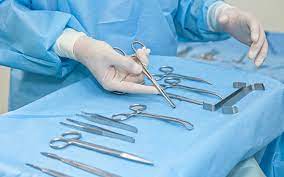In dental health care settings, all instrument cleaning, disinfecting, and
sterilizing should occur in a designated central processing area in order to more
easily control quality and ensure safety. The instrument processing area should
be physically divided into sections for 1) receiving, cleaning, and
decontamination; 2) preparation and packaging; 3) sterilization; and 4) storage.
This division is designed to contain contaminated items in an area designed
specically for cleaning, thus preventing contamination of the clean areas where
packaging, sterilization, and storage of sterile items occurs. Reusable
contaminated instruments and devices are received, sorted, and cleaned in the
cleaning area. The packaging area is for inspecting, assembling, and packaging
clean instruments in preparation for nal processing. The sterilization and
storage areas contain the sterilizers and related supplies, as well as incubators
for analyzing spore tests, and can contain enclosed storage for sterile items
and disposable (single-use) items. When it is not possible to have physical
separation of these areas, clearly labeling each area (e.g., from contaminated
to sterile) might be satisfactory if the personnel who process the instruments
are trained in work practices to prevent contamination of clean areas.
Why must instruments be cleaned before being sterilized?
Cleaning should precede all disinfection and sterilization processes. Cleaning
involves the removal of debris (organic or inorganic) from an instrument or
device. If visible debris is not removed, it will interfere with microbial
inactivation and can compromise the disinfection or sterilization process.
Which is the best method for cleaning instruments, manual (e.g., scrubbing
instruments with a brush) or automated?
Debris can be removed from an instrument either by scrubbing the instrument
manually with a surfactant or detergent and water or by using automated
equipment (e.g., ultrasonic cleaner, washer-disinfector) and chemical agents.
After cleaning, instruments should be rinsed with water to remove chemical or
detergent residue. Splashing should be minimized during rinsing and cleaning.
Considerations in selecting cleaning methods and equipment include their
effectiveness, their compatibility with the items to be cleaned, and the
occupational health and exposure risks they pose. Because instruments
cleaned with automated cleaning equipment do not need to be presoaked or
scrubbed, the use of automated equipment can increase productivity, improve
cleaning effectiveness, and decrease worker exposure to blood and body fluids.
Thus, using automated equipment can be more effcient and safer than manually
cleaning contaminated instruments.




No comment